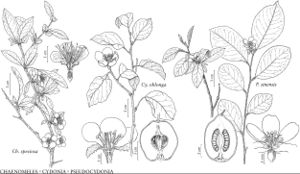Cydonia
Gard. Dict. Abr. ed. 4, vol. 1. 1754.
| Taxon | Illustrator ⠉ | |
|---|---|---|
 | Chaenomeles speciosa Cydonia oblonga Pseudocydonia sinensis | Marjorie C. Leggitt Marjorie C. Leggitt Marjorie C. Leggitt |
Trees, crowns rounded, (30–) 80 dm. Stems 1, sometimes several, erect or spreading; bark: older trunks gray, fissures dividing bark into rectangular plates; short-shoots absent; unarmed; young branches tomentose, glabrescent; buds ovoid, apex obtuse or acuminate, tomentose. Leaves deciduous, cauline, simple; stipules caducous, free, ovate, margins glandular-serrate; petiole present; blade broadly ovate to oblong, 5–10 cm, firm or leathery, margins flat, entire, venation pinnate, abaxial surface densely villous, adaxial glabrous. Inflorescences terminal on leafy branches, flowers solitary, densely hairy (tomentose) within, otherwise glabrous; bracts present similar to stipules; bracteoles absent. Pedicels present. Flowers developing with leaves, perianth and androecium epigynous, 40–50 mm diam.; hypanthium campanulate, ± constricted, 4–6 mm diam., inner rims hairy; sepals 5, reflexed, ovate or broadly lanceolate; petals 5, white or light pink, suborbiculate, ovate, or obovate, base short-clawed, apex rounded; stamens 20, equal to or slightly longer than petals; carpels 5, connate, adnate to hypanthium, ovaries 5-locular, tomentose, styles 5, terminal, distinct, ± equal to or 3/4 length of stamens, protruding through pit in top of hypanthium; ovules many. Fruits pomes, sessile or pedicellate, yellow, pyriform or subglobose, 30–50 mm, tomentose (sometimes tomentum ± rubbed off, with abundant, grouped stone or grit cells); fleshy; hypanthium persistent; sepals persistent, reflexed; carpels cartilaginous; styles ± persistent. Seeds many.
Distribution
Introduced; Asia, also in South America, Europe, Africa
Discussion
Species 1.
Cydonia is native from Iran to Turkestan; it is introduced and naturalized throughout much of temperate Asia and the Mediterranean region, where it has been cultivated for its edible fruit since ancient times.
The species of 'flowering quince' (Chaenomeles spp.) are often called quince, but this latter common name is best reserved for Cydonia oblonga.
Selected References
None.
Lower Taxa
"thin" is not a number.